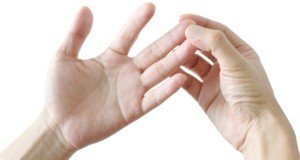
Have you noticed that sometimes, when your index or middle finger is against ANY part of your body, you feel a pulse—and you realize that this heartbeat is emanating from your fingertip?
At first you may think you’re feeling the pulse coming from the body part that the tip of your finger is against.
For example, suppose your arms are crossed, and your middle fingertip is somewhat pressing into the side of your torso.
You feel something throbbing in the fingertip and figure it’s from an artery under the skin of your torso.
And why not? After all, there are arteries everywhere in the body. Their job is to deliver oxygenated blood to every cell in the body.
But then you feel your pulse nearly anywhere you press a fingertip: upper part of your inner thigh; outside of your upper thigh; outside of the calf; on the foot; on the head, upper arm or butt.
Then one day when you feel the heartbeat in your fingertip – it’s against an inanimate object!
You now realize that all along, you’ve been feeling your pulse IN your finger, not through it.
This can alarm some people who suffer from health anxiety, while intrigue others without health anxiety.
Relax. Nothing Is Wrong.
There is nothing to be concerned about if you can feel a heartbeat there.
It doesn’t matter if the finger is against your shoulder, forehead, seat of your chair or pressed into a pillow that’s on your chest at night.
Your fingers have arteries, and you’re feeling your pulse there. It’s that simple.
You may now be wondering if this is an effective way to take your pulse, since sometimes, the radial artery (in the wrist) is troublesome to get a good sensation with.
And pressing too hard on the carotid artery of the neck can alter the sensation and result in a less-than-accurate reading.
Why not just press the fingertip into an inanimate object or against the side of your thigh while seated to get a pulse reading?
“I agree some people are able to appreciate their pulse through their finger, when pressed against an object, but it is not a reliable method for most people to use to evaluate their pulse,” says Glenn Meininger, MD, Director of Cardiac Electrophysiology Services for the Baltimore region of the MedStar Heart & Vascular Institute.
Dr. Meininger explains, “Best locations for a pulse check is either the radial artery, below the thumb side of the hand at the wrist, or the brachial artery, along the crease of the elbow.”

Dr. Meininger is board certified in cardiac electrophysiology, cardiovascular disease and internal medicine and is widely regarded as an expert in the use of multiple modalities to treat cardiac arrhythmias.
 Lorra Garrick has been covering medical, fitness and cybersecurity topics for many years, having written thousands of articles for print magazines and websites, including as a ghostwriter. She’s also a former ACE-certified personal trainer.
Lorra Garrick has been covering medical, fitness and cybersecurity topics for many years, having written thousands of articles for print magazines and websites, including as a ghostwriter. She’s also a former ACE-certified personal trainer.









































